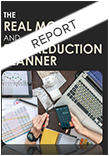Real Wealth Australia
Pay off your home loan to 5.2 Years!
Have you seen the headline being bantered around? Does it sound too good to be true? For years, property investors across Australia have used the following powerful strategy to convert bad debt to good debt, paying off their home loan in a few short years.
We all know the difference between “bad debt” (those personal debts that are not tax-deductible, such as credit cards and your owner-occupier home loan) and “good debt” (your investment loans that generate fully tax-deductible loan repayments). Obviously, the fewer bad debts you have, the better for your finances and investing goals.
How does this strategy work?
The aim of this strategy was to shift your debt so that virtually every interest expense you incur was tax deductible. The result was often years shaved off your owner-occupier mortgage loan term and conversion of all of your interest repayments to become tax deductible, with no increase in payments.
To make this work, you needed:
- a home loan;
- an investment loan; and
- a line of credit loan to fund interest on the investment loan.
No cash was required from the borrower to pay interest on the investment loan, because the interest was paid from the line of credit, which had no monthly repayment obligation.
Therefore, that interest was capitalised on the line of credit and the borrower deposited all rental income received – say, $350 per week, or $18,000 annually – into their own mortgage. These payments were made on top of regular mortgage payments to reduce the outstanding balance of the owner-occupier (non tax-deductible) home loan more quickly.
WARNING – The ATO now sees this strategy as tax avoidance.
A recent ruling by the Australian Tax Office (ATO) has changed the rules and put an end to landlords employing this strategy. If you are using the following method to maximise your tax deductions, contact your accountant immediately to find out whether the new Taxation Determination TD 2012/1 (Determination) impacts you.
In March 2012, the Commissioner of Taxation issued Taxation Determination TD 2012/1 (Determination) in relation structures such as these, described as “investment loan interest payment” arrangements.
The tax office rejected claims by borrowers that these arrangements are entered into for the purpose of paying their home loan off sooner and determined that these structures breach anti-tax avoidance rules, “designed to prevent taxpayers [from] obtaining tax benefits from blatant, artificial or contrived tax avoidance schemes”.
They caution taxpayers against using this type of mortgage structure and warn that if they do, many of the interest deductions will be cancelled and financial penalties will apply.
Read more about the new Taxation Determination here and if you’re concerned you may be in breach of anti-tax avoidance rules, contact your accountant immediately.
Although in principal this was a great strategy for investors, the rules have changed and you need to be aware of the implications.
Real Wealth Australia
Share this post
Become a successful Property Investor















